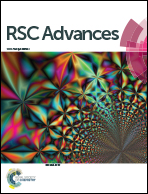Structural characterization of metal dopants (M = Ag or Au) in trimetallic M–Pd–Pt clusters
Abstract
The structures and properties of bimetallic Pd–Pt clusters are affected by altering the metal dopants in trimetallic M–Pd–Pt (M = Ag and Au) clusters. The M–Pd–Pt clusters with up to 75 atoms are studied to investigate the structural difference caused by metal dopants, which are optimized using an adaptive immune optimization algorithm (AIOA). The tight-binding Gupta potential is adopted to describe the interatomic interactions in the trimetallic clusters. Results show that there exist significant differences between the stable structures of Ag–Pd–Pt and Au–Pd–Pt clusters for the investigated clusters. The dominant motif of 13-atom clusters is a Mackay icosahedron except for some non-icosahedral configurations, and the number of non-icosahedra in Au–Pd–Pt clusters is larger than that in Ag–Pd–Pt clusters. Furthermore, there exist many mixed decahedron/close-packed motifs in both clusters as for Pd–Pt clusters. It is also the dominant motif of 75-atom Ag–Pd–Pt clusters, however, in Au–Pd–Pt clusters the corresponding motif is Marks decahedron. Moreover, the atomic distribution of Pd and Pt atoms in Ag–Pd–Pt clusters is similar to that in Au–Pd–Pt clusters, but the Au atoms grow more closely than the Ag atoms. The relative stability for both clusters is compared by the second order finite difference parameter.


 Please wait while we load your content...
Please wait while we load your content...